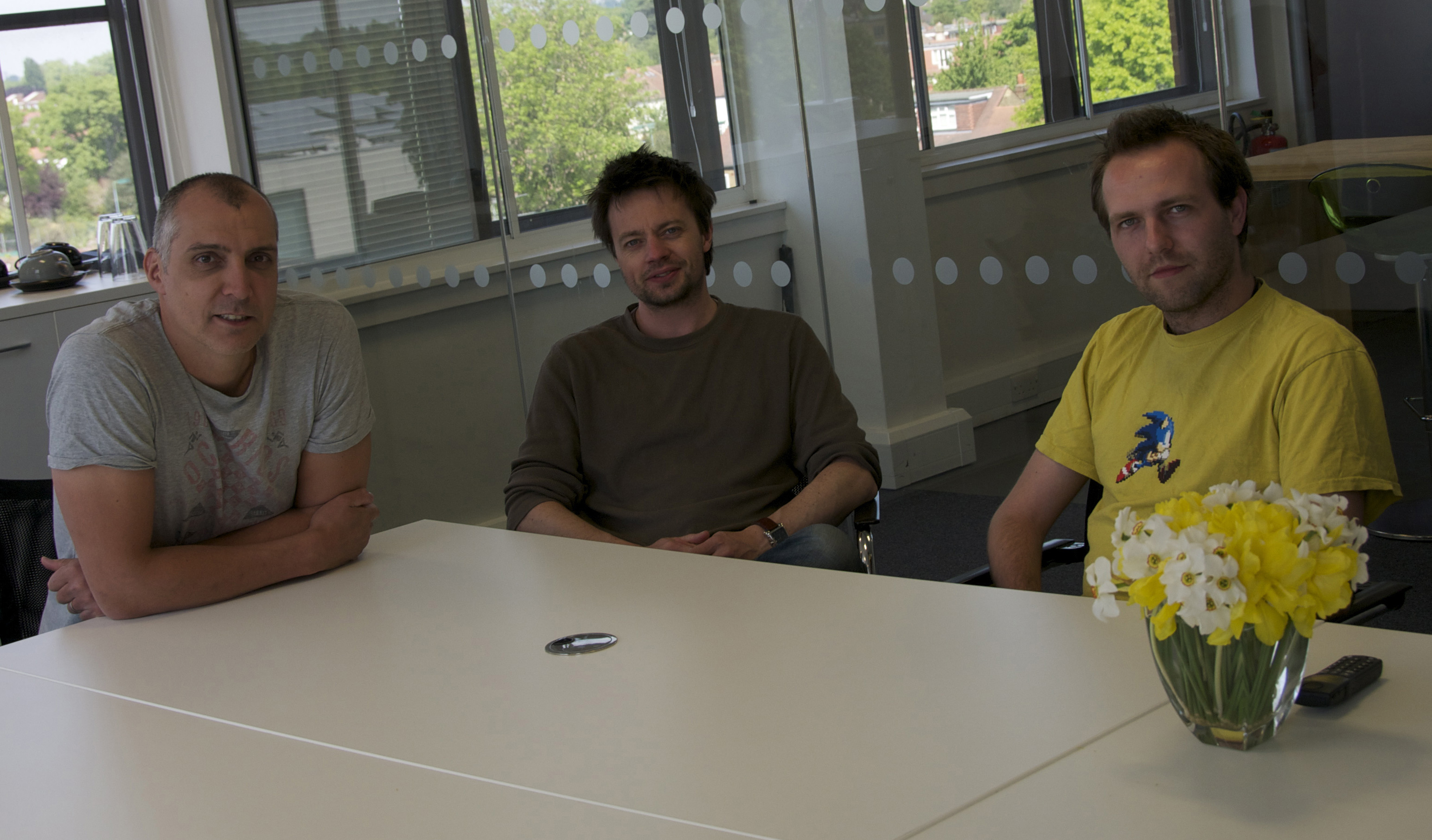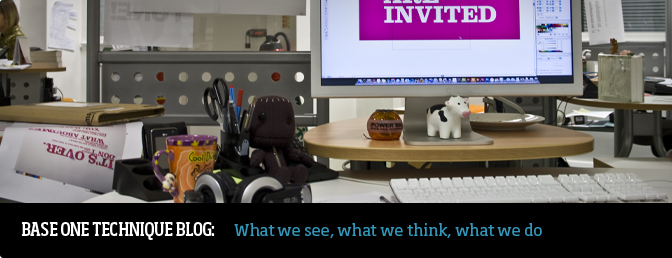Recently in Inspiration Category
You'll need a decent modern browser (Safari or Chrome) to see this:
http://bartaz.github.com/impress.js/#/overview
Enjoy!
No Comments
David Thomas, the company's Creative Director, and my contact at Base One, gave me my first task - which was to interview everyone at the company to find out what Base One do. Although he did chuck me straight into the deep end with this job, I did find the interviews very helpful, as not only did I find out what Base One do, I also found some interesting job titles and some interesting stories of how they got into the business. The three people who had the most interesting stories (in my opinion) are:
Dean, Matt, Gabriel.

Who he is: Dean is a
senior Art Director at Base One. He is a graphic designer for print work, brand
work, corporate identity and he also specialises in photography.
What he does: Dean's average day
consists of project briefing, design and art direction, photographic art
direction and location photography.
Why he does it: Dean is very artistic as a person and decided to go to art college
to study design and photography - but then focused solely on design work. After
leaving, he went to a small marketing company and then moved on to Base One.
MATT
Who he is: Matt is
the Senior Copywriter at Base One. This consists of proofreading and editing,
working in partnership with designers to come up with ideas for marketing
campaigns, and writing a hell of a lot.
What he does: Matt's average day
consists of meetings about 'briefs' (documents that let everyone know what work
for their clients needs to be done) and then writing the copy (the literature)
for whatever the brief asks for - so that could be thinking and writing about a
'big idea' for a new marketing campaign, or writing copy for an email, a
leaflet, or website copy (he roughly works on two to three different briefs a
day). He works out the main things to say about the client's product or
service, and plans out the writing structure, making sure that it answers the
brief. He also has occasional meetings if a client has any suggestions related
to the work.
Why he does it: After university, Matt became a Runner for a T.V. commercials company, and then moved on to become a freelance Assistant Director in T.V commercials and films. Afterwards, he went to a start-up web company, writing marketing literature, and then moved on to working at EA, where he wrote marketing copy and games manuals. He then moved into the copywriting business, becoming a 'midweight' copywriter and then became Senior Copywriter at Base One.
GABRIEL
What he does: Gabriel's average day
consists of handling projects, speaking to designers and copywriters, checking
urgent e-mails from clients and colleagues, and booking people to do upcoming
work.
Why he does it: Gabriel used to work
for Sega, but became redundant. Rather than going back into the games industry,
he followed his interest in web designing (he also felt the games industry
wasn't taken seriously). He went into web design not just because of his
interest, but because he wanted to see how far he could go in the design
industry and wanted to be able to keep learning, as there's always new
technology going into web design.

It seems to me that nearly every ad on the box these days tries to annoy you into buying their products. Whether it's irritating jingles, weird puppets or damn right nonsensical industry jargon, ads seem to be more ridiculous and unbearable than ever before.
Before you start shooting me down, I'm well aware that for many advertising agencies this is exactly the intention. They want to invent situations so ridiculous or so grating that you can't possibly forget them or their brands in the future. They become part of your subconscious so that the next time you come to get insurance, sell your gold via mail(!) or use a search comparison site, their logo is etched well and truly into your brain. Whether you like it or not.
But this has got me wondering: does this mean we're more likely to buy their products? I, for example, dislike Gio Compario, the star of the Go Compare ads (see above), so much that I would rather pay more to use another brand that doesn't make me want to kill.
I admit I'm probably fighting a losing battle because I'm sure they're here to stay. They're obviously working because there are more and more. So, instead, I'll give my top 10 most hated TV ads. And if there are any that you think I've missed, let me know using the comment form below. Enjoy.

5 Comments

As a professional writer, I spend a lot of time with thesauri. (Yes, that's a legitimate plural.) But even if your job doesn't depend on word choice, wordhunting can be very worthwhile. Do you use Twitter, for instance? Then you can only afford so many words per tweet, and you'll want to make sure they say exactly what you mean.
To make wordhunting a pleasure, you need the kind of convenient go-to references that give you eureka moments. And you might want different ones for different tasks.
For instance, I use different (or more) resources for naming projects than I do for my long-copy jobs. Some of these resources wouldn't actually be called a thesaurus, but they can lead you to what you want to say. All of my favourite wordfinders are online and most of them are free. Read on...
Everyone in marketing should see this video. In fact, just everyone should see it.
If you, like me, are concerned about the gradual decline in the quality of spoken English, you'll love it. And it will remind you why you make the effort to not only speak properly, but to insist on clear, correct communications when writing content that is designed for customers. The voice behind the video is teacher and poet Taylor Mali (assisted by great typography by Ronnie Bruce by the way) who makes the point more articulately and humorously than I ever could. Oh, and big thanks to my colleague and fellow writer Noel Ponthieux for bringing it to my attention.
It's just like totally awesome, ya know.

This is just one of the many staggering statistics that have been published recently by Facebook as it celebrates its latest user milestone.
Others amazing stats include the fact that 23m people in the UK are registered Facebook users, and that 50% of UK those users visit daily, with an average time of 55 minutes spent per day on Facebook.
Now maybe my maths is a little suspect, but I think this means that around 10 million hours per day are spent on Facebook. Assuming the average working day is 8 hours, that is around 1.2 million working days. The working population is 33 million, so I amateurishly conclude that for every hour the average UK worker spends working, they also spend about three minutes checking for updates on Facebook. Incredible.
I came across this "painfully honest" TV commercial.
It got me thinking about the approach most adverts take.
Being advertised to is a part of life,
deconstructing all these messages is second nature to everyone and because we know
we're being sold to, we digest adverts with a pinch of salt - obviously we're
only going to be presented with only the good points and benefits, obviously
the message with be slightly to extremely skewed.
That's why building trust is so important and difficult with a brand and why I found this Cullman Liquidation Mobile Home commercial so refreshing and exciting.
While the ad itself has neither high or low production values, the way it's presented and written is so honest I can't help but respect it, sit up and listen.
The question is, would I buy a mobile home if I was in the market for one and obviously had a modest budget?
I found this interesting, not just because it is a neat parody of the iPhone ad, but because of the attitude of the newspaper behind it (The Sun, the UK's notorious tabloid).
News Corporation, the owners of the Sun, has recently shown how uncomfortable it is with new technology by claiming that free-access, ad-funded information is not viable. And here it is having a go at the darling of the Web 2.0 generation. So is the Sun right to be positioning itself in such a backward-looking light? Is it winning over lots of techno-sceptic readers who themselves are terrified at the advance of technology? Or does it just end up looking a little silly and behind the times?
2 Comments
NamingofParts.mp3
Hope you enjoy it...I first heard it when my literature professor read it aloud soon after the first Gulf War began, and it gave me shivers. I thought the quiet tone and personal view of a soldier most appropriate to share on a reflective day.
Naming of Parts
To-day we have naming of parts. Yesterday,
We had daily cleaning. And to-morrow morning,
We shall have what to do after firing. But to-day,
To-day we have naming of parts. Japonica
Glistens like coral in all of the neighboring gardens,
And to-day we have naming of parts.
This is the lower sling swivel. And this
Is the upper sling swivel, whose use you will see,
When you are given your slings. And this is the piling swivel,
Which in your case you have not got. The branches
Hold in the gardens their silent, eloquent gestures,
Which in our case we have not got.
This is the safety-catch, which is always released
With an easy flick of the thumb. And please do not let me
See anyone using his finger. You can do it quite easy
If you have any strength in your thumb. The blossoms
Are fragile and motionless, never letting anyone see
Any of them using their finger.
And this you can see is the bolt. The purpose of this
Is to open the breech, as you see. We can slide it
Rapidly backwards and forwards: we call this
Easing the spring. And rapidly backwards and forwards
The early bees are assaulting and fumbling the flowers:
They call it easing the Spring.
They call it easing the Spring: it is perfectly easy
If you have any strength in your thumb: like the bolt,
And the breech, and the cocking-piece, and the point of balance,
Which in our case we have not got; and the almond-blossom
Silent in all of the gardens and the bees going backwards and forwards,
For to-day we have naming of parts.
PS: Mr Fiennes' reading is from the most excellent Poetry Corner.
No Comments
"You can't solve the problem with the thinking that created the problem" Albert Einstein.
If that's the case, how long should you sit and try to find a solution?
That was the first thing we were told at the IPA's morning energiser on 'How to run brainstorms and solve problems creatively' with Mia Kennedy. A fairly simple question, but no one gave the same answer.
I am a designer and have only really sat in on a few brainstorming sessions with a big group and sometimes found them unstructured, unplanned or unmotivated, and sometimes no real convincing or solid idea that everyone understands came out of them.
A new perspective on brainstorming
The morning started with an overview of how this method of brainstorm planning works and the order in which it runs to best maintain a productive flow. They also explained how the process had to be flexible enough that parts can be omitted if time, understanding or the need for a full blown brainstorm aren't required.
Another nugget was the roles that are played by the people in the brainstorming session - ie the FACILITATOR, PROBLEM OWNER (P.O.) and the RESOURCE.
FACILITATOR: can be anyone in the session other than the P.O., but the key point of this person's role is that they don't contribute to the meeting at all, they steer it along and write down and record the comments for the session.
P.O.: this can be the client, or the account handler or project manager, but this person MUST have the ability to actually effect the outcome of the session.
RESOURCE: or the brains for hire, as they were called. These can be anyone, anyone who knows the client in question, or the job - but importantly, it can be someone who knows nothing about the client or job, and these people could actually bring more productivity to the session as they won't be restricted to ideas, as they have no preconceptions. And their role is to contribute ideas, pose questions and be able to think freely with no restriction in the session (There's no such thing as a bad idea).
One fairly interesting process that was used was something called 'forward and backward planning.' Now I had heard of this but never looked into what it was about or how it works.
The forward and backward planning is a starting point where, with the Headline problem brought to the brainstorming session is written down in a H2 (how to) or IW (I wish) statement - then by the facilitator asking what issues would be resolved by answering this headline problem and what benefits can it give by answering the headline problem. This then highlights a more resolved/clear/different headline question that could help in the brainstorming session.
Love, marriage and problem resolution
I was asked to give an example for this, and as I am getting married I was asked to give my headline problem. So I said.....
'H2 have less stress with wedding planning'
My backward planning (what issues would be resolved) was 'reduces conversations on wedding planning' and 'less frustration with planning' and forward planning (what benefits can it give) was 'we don't have to go over old ground' and 'feel more comfortable to explore ideas without adding frustration or commitment to an idea'.
For me I realised that the last comment in the forward planning was actually the main issue of the stress. So now the facilitator said, the headline problem has now changed from 'H2 have less stress with wedding planning' to 'H2 feel more comfortable to explore ideas without adding frustration or commitment to an idea'. This was then taken into the further stages of the brainstorming process.
Anyway, enough about me.
After listening to and using Mia's processes in the morning energiser, I realised that a brainstorm can be fruitful without having to be too long - that by structuring ideas into a 'frameworked' statement that it gets the contributor to actually think before they speak and means that all that brainstorm meeting waffle should disappear, and a more exciting, energetic and productive brainstorm session can be had. If this sounds like something interesting to you, Mia can come and run a session for you.
Why wouldn't you?








